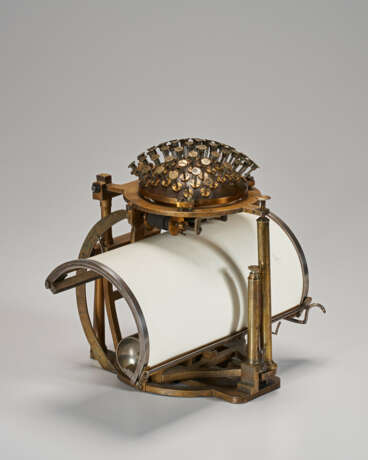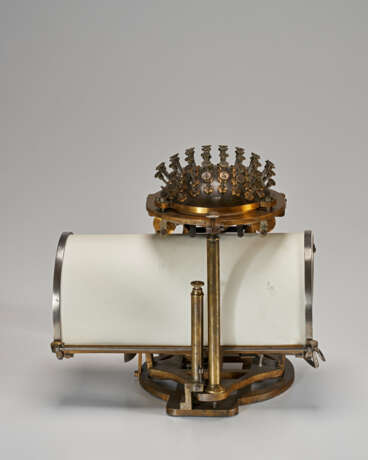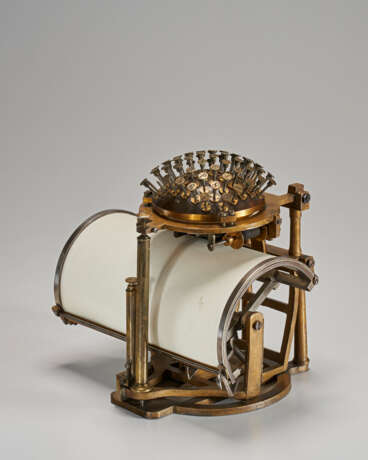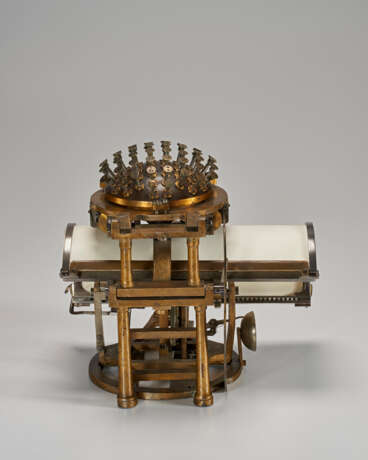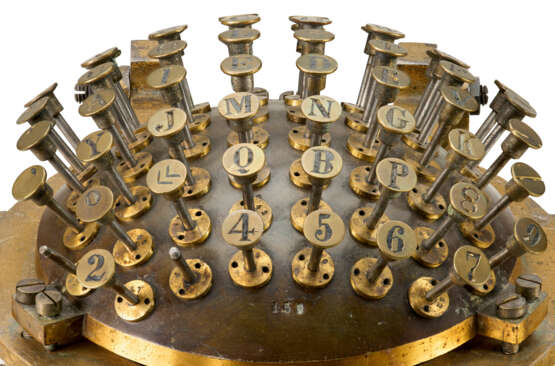ID 1279137
Lot 5 | A MALLING-HANSEN WRITING BALL
Estimate value
$ 50 000 – 80 000
HANS RASMUS JOHAN MALLING-HANSEN, 1867
Serial number 159 stamped on the hemi-spherical alpha-numeric keypad
Supported on brass columns with arc for paper carriage
A pivotal advancement in the history of typewriting technology.
The Malling-Hansen Writing Ball, invented by its namesake in 1865, is an innovative device that embodied several key design features that influenced subsequent developments in the field of mechanical writing instruments.
Rasmus Malling-Hansen, a Danish pastor and principal of the Royal Institute for the Deaf in Copenhagen, developed the Writing Ball with the primary aim of improving the efficiency and speed of written communication specifically targeted at those with disabilities. Utilizing electric current to propel the typing mechanism, Hansen’s Writing Ball is one of the earliest instances of electric typewriters. However, beyond its electrical innovation, the symbiotic design helped distinguish the machine as the most ergonomic of its day. Featuring a completely unique hemispherical keyboard layout, this spherical configuration sought to minimize finger movement and reduce typing fatigue: the keys were arranged in a honeycomb-like structure, and utilized a complex system of levers and escapements, thus ensuring a precise and consistent pressure on the paper; and the paper carriage was moved by a clockwork mechanism, ensuring the smooth operation and high typing speed. Furthermore, the innovative paper feed system allowed for continuous typing without the need for manual intervention. Indeed, the ingenuity of the mechanical design saw a revolutionary step in the development of typing that placed more onus on user comfort and efficiency—the Writing Ball reportedly enabling typists to reach speeds of up to 800 characters per minute.
However, despite its technological advancements, the Malling-Hansen Writing Ball faced several challenges that hindered its widespread adoption. The complexity and cost of manufacturing the device were significant barriers, and it was eventually overshadowed by the more commercially viable Sholes and Glidden typewriter, which introduced the QWERTY keyboard layout that became the industry standard. Ultimately, although it did not achieve lasting commercial success, the Writing Ball remains a critical milestone, highlighting the iterative nature of technological advancement and the continuous quest for improved efficiency in human-machine interaction.
10 in. (25.4 cm.) high, 11 in. (27.9 cm.) wide, 8 1/2 in. (21.6 cm.) deep
Provenance
Anonymous sale, Auction Team Breker, 25 May 2002, lot 186.
Acquired at the above sale by the late owner.
Further details
This lot is subject to additional disclaimers. Please carefully review Section E(2), subsection (m) “Vintage Computers and Machines”.
| Applied technique: | Metalwork |
|---|---|
| Medium: | Brass |
| Place of origin: | Western Europe, Europe, The Netherlands |
| Auction house category: | All other types of objects |
| Applied technique: | Metalwork |
|---|---|
| Medium: | Brass |
| Place of origin: | Western Europe, Europe, The Netherlands |
| Auction house category: | All other types of objects |
| Address of auction |
CHRISTIE'S 8 King Street, St. James's SW1Y 6QT London United Kingdom | |
|---|---|---|
| Preview |
| |
| Phone | +44 (0)20 7839 9060 | |
| Buyer Premium | see on Website | |
| Conditions of purchase | Conditions of purchase |
